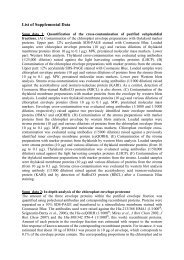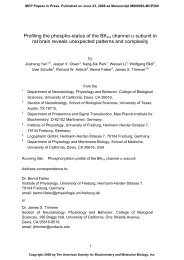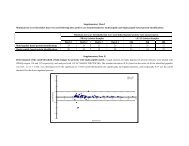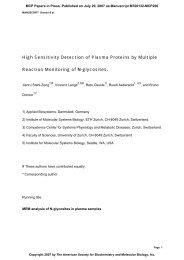Super-SILAC allows Classification of Diffuse Large B-cell ...
Super-SILAC allows Classification of Diffuse Large B-cell ...
Super-SILAC allows Classification of Diffuse Large B-cell ...
You also want an ePaper? Increase the reach of your titles
YUMPU automatically turns print PDFs into web optimized ePapers that Google loves.
Thermo Fisher Scientific). Mass spectra were acquired on the Q Exactive in a data dependent mode with<br />
an automatic switch between a full scan and up to 10 data-dependent MS/MS scans. Target value for<br />
the full scan MS spectra was 3,000,000 with a maximum injection time <strong>of</strong> 20 ms and a resolution <strong>of</strong><br />
70,000 at m/z 400. The ten most intense ions with charge two or more from the survey scan were<br />
selected with an isolation window <strong>of</strong> 1.6 Th and fragmented by HCD (25) with normalized collision<br />
energies <strong>of</strong> 25. The ion target value for MS/MS was set to 1,000,000 with a maximum injection time <strong>of</strong><br />
60 ms and a resolution <strong>of</strong> 17,500 at m/z 400. These settings lead to constant injection times <strong>of</strong> 60 ms –<br />
fully in parallel with transient acquisition <strong>of</strong> the previous scan – ensuring fast cycle times. Repeat<br />
sequencing <strong>of</strong> peptides was kept to a minimum by dynamic exclusion <strong>of</strong> the sequenced peptides for 25<br />
s.<br />
Data Analysis – Acquired raw files were analyzed by MaxQuant (28) (version 1.2.0.34). Andromeda, a<br />
probabilistic search engine incorporated in to the MaxQuant framework (29), was used to search the<br />
peak lists against the IPI-human database version 3.68 which contains 87,083 entries. Common<br />
contaminants were added to this database. The search included cysteine carbamidomethylation as a<br />
fixed modification and N-terminal acetylation and methionine oxidation as variable modifications. The<br />
2 nd peptide identification option in Andromeda was enabled (29). For statistical evaluation <strong>of</strong> the data<br />
obtained, the posterior error probability and false discovery rate (FDR) were used. The FDR was<br />
determined by searching a reverse database. An FDR <strong>of</strong> 0.01 for proteins and peptides was required.<br />
Enzyme specificity was set to trypsin allowing N-terminal cleavage to proline. Two miscleavages were<br />
allowed and a minimum <strong>of</strong> six amino acids per identified peptide were required. Peptide identification<br />
was based on a search with an initial mass deviation <strong>of</strong> the precursor ion <strong>of</strong> up to 6 ppm and the allowed<br />
fragment mass deviation was set to 20 ppm. The mass accuracy <strong>of</strong> the precursor ions was improved by<br />
retention time dependent mass recalibration (28). To match identifications across different replicates<br />
and adjacent fractions, the ‘match between runs’ option in MaxQuant was enabled within a time<br />
[8]








